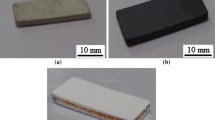Abstract
Thermoelectric generator (TEG) offers a potential application in harvesting waste-heat energy into usable electrical power. β-iron disilicide (β-FeSi2) thermoelectric is applicable in elevated temperature systems such as hydrogen plants, copper reverberatory furnace and copper refining furnace. In this work, high TE performance Mn doped p-type and Co doped n-type thermoelectric (TE) β-iron disilicide compacts were fabricated for TEG using powder metallurgy route. The effects of variation in type and quantity of dopants [p-type dopant: Mn: stoichiometry Fe1−xMnxSi2 (x = 0.04 − 0.12) or n-type dopant: Co: stoichiometry Fe1−yCoySi2 (y = 0.01 − 0.05)] on thermoelectric properties were studied. Significant improvement in ZT was observed compared to earlier research works for this material system. This result is a positive indication for the potential use of β-FeSi2 in the high temperature TEG. In this work, the working efficiency was also evaluated which was not mentioned in the earlier research works.










Similar content being viewed by others
References
Jaziri N, Boughamoura A, Müller J, Tounsi F, and Ismail M, Energy Rep (2019).
Ur S C and Kim I H, Met Mater Int 11 (2005) 303.
da Rosa A V, Fundamentals of Renewable Energy Resources, 3rd edn, Academic Press, Stanford University, Stanford, Cambridge (2013), pp. 171–172.
Poddar V, Dhokey N, Garbade R, Butee S, Prakash D, and Purohit R, Mater Sci Semicond Process 71 (2017) 478.
Cai K F, Mueller E, Drasar C, and Stiewe C, Solid State Commun 131 (2004) 328.
Qu X, Wang W, Liu W, Yang Z, Duan X, and Jia D, Mater Chem Phys 129 (2011) 335.
Chen H Y, Zhao X B, Stiewe C, Platzek D, and Mueller E, J Alloys Compd 433 (2007) 344.
Gross E, Riffel M, and Stoehrer U, J Mater Res 10 (1995) 36.
Nogi K and Kita T, J Mater Sci 35 (2000) 5849.
Poddar V and Dhokey N, Trans Indian Inst Met 72 (2019) 2711.
Hasan R and Ur S C, J Elec Mater 49 (2020) 2719.
Kiatgamolchai S, Parinyataramas J, Nilpairach S, Thueploy A, Wanichsampan J, and Min G, Acta Metall Slov 12 (2006) 121.
Kim S W, Cho M K, Mishima Y, and Choi D C, Intermetallics 11 (2003) 399.
Desimoni J, Cotes S M, Taylor M A, Martinez J, and Runco J, Intermetallics 15 (2007) 1302.
Chai J, Chen M, Du X, Qiu P, Sun Y, and Chen L, Phys Chem Chem Phys (2019).
Clark S J, Al-Allak H M, Brand S, and Abram R A, Phys Rev B 58 (1998) 389.
Zhang L, Du Y, Xu H, and Pan Z, Calphad 30 (2006) 480.
Ohtaki M, Oxide Thin Films, Multilayers, and Nanocomposites, 1st edn, Springer, Berlin (2015) pp. 109–122.
Lee Y-G, Choia M-K, Kim I-H, and Ur S-C, J Ceram Process Res 13 (2012) 818.
Chen H Y, Zhao X B, Lu Y F, Mueller E, and Mrotzek A, J Appl Phys 94 (2003) 6625.
Kim H-S, Gibbs Z M, Tang Y, Wang H, and Snyder G J, APL Mater 3 (2015) 041506-2.
Ioffe A and Stil’bans L S, Rep Prog Phys 22 (1957) 184.
Vining C B, in CRC Handbook of Thermoelectrics, (ed) Rowe D M, CRC Press, Boca Raton (1995), p. 277.
Fedorov M, J Thermoelectr 2 (2009) 52.
Acknowledgements
The authors are very much grateful to SPPU, Pune for providing XRD analysis facility and to IISER, Pune, and BRNS, Mumbai, for providing thermoelectric evaluation facility.
Author information
Authors and Affiliations
Corresponding author
Additional information
Publisher's Note
Springer Nature remains neutral with regard to jurisdictional claims in published maps and institutional affiliations.
Rights and permissions
About this article
Cite this article
Poddar, V.S., Dhokey, N.B. Evaluation of Thermoelectric Properties of Doped β-Iron Disilicide Prepared by the Powder Metallurgy Technique. Trans Indian Inst Met 74, 399–410 (2021). https://doi.org/10.1007/s12666-020-02167-5
Received:
Accepted:
Published:
Issue Date:
DOI: https://doi.org/10.1007/s12666-020-02167-5




